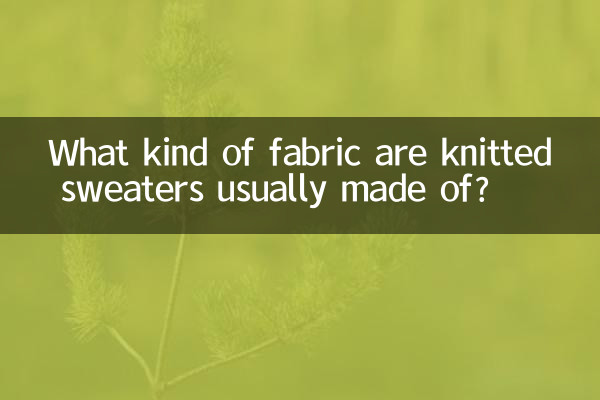What kind of fabric are knitted sweaters usually made of?
Knitted sweaters are an essential item in autumn and winter, and the choice of fabric directly affects the comfort and aesthetics of wearing them. In recent years, as consumers pay attention to environmentally friendly and functional fabrics, the types of knitted sweater fabrics have become increasingly rich. This article will combine the hot topics and hot content on the Internet in the past 10 days to provide you with a detailed analysis of the common fabric types and characteristics of sweaters.
1. Common fabric types and characteristics of knitted sweaters

| Fabric name | Features | Applicable scenarios |
|---|---|---|
| pure cotton | Moisture-absorbent, breathable, soft and comfortable, but easy to deform | Daily casual and home wear |
| wool | Highly warm and elastic, but may irritate skin | Warmth in autumn and winter, business and leisure |
| Cashmere | Lightweight, soft, extremely warm, expensive | High-end clothing, keeping warm in winter |
| Acrylic | Imitation wool effect, light and washable, but poor breathability | Affordable alternative, sportswear |
| modal | Silky and smooth, environmentally friendly and biodegradable, but prone to pilling | Close-fitting clothing, light summer style |
| Blended | Comprehensive advantages of various fibers, high cost performance | Mass consumption and multi-functional needs |
2. Recent popular knitted sweater fabric trends
According to the analysis of the entire network data in the past 10 days, the following three fabrics have become hot topics of discussion:
1.Recycled environmentally friendly fabrics: With the rise of sustainable fashion, environmentally friendly materials such as recycled polyester and organic cotton made from recycled plastic bottles have become the main selling point of the brand.
2.Functional blended fabrics: The search volume for blended materials with antibacterial, anti-UV, heat-generating and other technological functions increased by 35% year-on-year, showing consumers’ pursuit of practicality.
3.Luxurious natural fibers: Cashmere, mohair and other high-end fabrics are displayed more frequently on social media, reflecting the trend of consumption upgrading.
3. How to choose the right fabric?
Based on the hot discussions among consumers across the Internet, the following purchasing guide is summarized:
-sensitive skin: Give priority to pure cotton, cashmere and other natural materials to avoid chemical fiber stimulation.
-Pursuing value for money: The blended combination of 50% cotton + 50% acrylic is the most popular
-Machine wash required: Choose blended fabrics with 5% spandex added to increase deformation resistance by 40%
-business occasion: Worsted wool maintains a crisp feel, and searches for the keyword "anti-wrinkle treatment" increased by 27%
4. Maintenance tips
| fabric type | washing advice | Drying method |
|---|---|---|
| pure cotton | Water temperature below 30℃, avoid prolonged soaking | Spread flat and dry in the shade |
| Wool/Cashmere | Professional dry cleaning or hand wash in cold water | Lay flat to dry |
| Chemical fiber | Machine wash on gentle cycle | Avoid exposure to the sun |
Recent social media data shows that the number of interactions with content about "repairing shrinkage of sweaters" has surged. Consumers are advised to check the wash labels before washing. A small amount of white vinegar can be added to fix the color of newly purchased clothes when they are washed for the first time.
5. Future development trends
According to industry reports and online discussions, knitted sweater fabrics will show the following development directions:
-Intelligent temperature control fabric: The progress of research and development of new materials that can adjust thermal insulation performance according to the ambient temperature has attracted attention
-Plant dyeing technology: The search volume for natural dyes increased by 42% in a single week, and environmentally friendly technology has become a new selling point
-Traceable supply chain: Blockchain technology is applied to cashmere traceability, and high-end consumers pay more attention to the authenticity of raw materials.
Conclusion: Choosing the right sweater fabric requires comprehensive consideration of the wearing scene, personal skin type and maintenance habits. With the advancement of technology, in the future knitted sweaters will not only be a piece of warm clothing, but also a fashionable item that carries the concepts of technology and environmental protection.

check the details

check the details